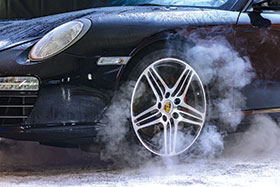

Test rigs are used extensively in the automotive and aerospace industries to test a variety of vehicles. AC variable speed drives are very well suited to test rig applications as they can be used to simulate real conditions in a highly dynamic, accurate, linear and repeatable way. They are very responsive and can stop and start quickly to replicate high speed events. Regenerative drives are also often used, so that the drive is able to regenerate electric power when the motor is absorbing energy or providing a load, returning this energy to the supply and reducing operational costs. All drives used in these applications should be optimised for energy efficiency and high control precision, with low ripple voltage and current. Excellent torque response is vital, because drives are often used as torque amplifiers, so the time from the torque reference to the torque on the motor shaft needs to be minimised.
The chassis dynamometer
The most common types of automotive test rig are chassis dynamometers, engine dynamo-meters and transmission rigs. Chassis dynamometer testing usually employs one drive and motor per test unit axle or wheel, depending on the type of testing being performed.
CP Engineering manufactures engine and chassis dynamometer test systems, transmission test systems and other test rigs for the automotive industry. The analog interface of CP’s Cadet Windows-based control and datalogging system is synchronised to the drive’s closed loop vector control. The test systems require real-time control and processing, precisely synchronised to give the same load/speed profile as a real vehicle. The response of the control loop must thus remain consistently within a given cycle time, typically 3,25 ms. The drive also has to be capable of motoring to simulate over-run conditions.
Cranking software provides protection for the drive shaft. As the engine fires and accelerates, the drive switches to zero torque to simulate engine idling. This cannot be done with conventional dynamometers.
Rolling road and brake test stands
Here, different test profiles and tracks are simulated and pre-programmed to reproduce driving resistances as realistically as possible, including braking, startup, driving round bends, cross-country and offroading. Internal and safety-related vehicle functions such as ABS and EPS are also tested. Through fast response compensation, highly accurate and reproducible measurements are obtained by taking into account the friction, electrical and thermal dependencies and moments of inertia over the entire powertrain.
Engine test stands
Drive systems are used in engine test stands, both in development centres and in motor manufacturing. The key is to simulate everyday operating conditions accurately. There are specific requirements for the quality assessment of combustion and electric engines, such as different test patterns and speeds, torque and counter torque cycles, endurance tests or short-term loads.
Frequency converters can accurately create the required torque curve, while also recycling the energy generated in the combustion engine, thereby sparing the electrical mains supply from sinusoidal mains currents. Test engineers can also subject the test sample to specific speeds and torques that expose resonances and technological limits.
Transmission/gearbox test stands
Here, the torque pulses and running characteristics of an internal combustion engine are applied to the transmission/gearbox being tested. By networking all drive controllers on real-time Ethernet, the necessary synchronisation of the inverter current and speed control circuits ensures that the test results reflect real conditions. This avoids the need for unwanted balancing adjustments in the control system.
Power electronics serve as input and output drives for a wide variety of transmission/gearbox types. Four load machines replace the wheel/road system and represent the driving profile, while an input drive simulates the internal combustion engine. Engine Torque Pulsation Simulation (ETPS) recreates the internal combustion engine on a development test stand. To meet the high requirements for this type of test stand, low mass inertia permanent magnet synchronous motors and asynchronous motors are used.
Testing equipment for electric vehicles
New developments require new testing techniques. The power train on hybrid and electrically powered vehicles, comprising the vehicle inverter, motor/engine and transmission/gearbox, can be tested as a complete system, connected in a common DC bus configuration which allows regenerated power (during braking for instance) to be recirculated. For a given installed motor power, this means that the grid connected inverter’s power rating is minimised, saving capital as well as energy costs. A key feature of the system is that all control loops are synchronised, which significantly reduces the risk of system resonances.
For more information contact Ryan Chetty, Nidec Industrial Automation Southern Africa, +27 (0)11 462 1740, [email protected], www.nidecautomation.com
| Tel: | +27 11 462 1740 |
| Fax: | +27 11 462 1941 |
| Email: | [email protected] |
| www: | www.nidecautomation.com |
| Articles: | More information and articles about Nidec Industrial Automation Southern Africa |

© Technews Publishing (Pty) Ltd | All Rights Reserved